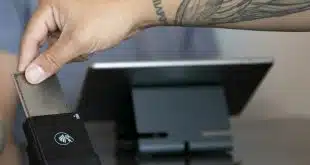Online retailer Amazon.com Inc. appears to have bought tablet and mobile point-of-sale provider GoPago Inc., according to a report in La Repubblica, an Italy-based newspaper.
In the report, Vincenzo Di Nicola, a GoPago co-founder and its chief technology officer, says Amazon paid an undisclosed amount for the company. The article, first reported by blogging site TechCrunch, did not say when the sale happened. Indeed, neither GoPago nor Amazon responded to Digital Transactions News inquiries.
GoPago, founded in 2009 and backed by a 2012 investment of an undisclosed amount from JP Morgan Chase & Co., offers merchants a tablet-based POS system that includes payment processing, cellular connectivity, sales reporting, data aggregation, and a mobile storefront and mobile payment via an app.
If the report of the sale is true, it could indicate yet another attempt by Amazon to entrench itself with merchants and consumers, analysts suggest. It could also presage a move by the online retailing giant into the physical point of sale.
“GoPago is one of the better wallets available,” says Mary T. Monahan, executive vice president and research director for mobile at payments research firm Javelin Strategy & Research, Pleasanton, Calif. For her, the mashup suggests the possibility of a PayPal-like endeavor attempting to extend an online experience into physical stores. “Could we possibly be seeing another Internet player developing a total shopping experience?” she asks. “Mobile allows us to link the online and physical worlds and the major online platforms see the need to close the loop between these worlds.”
Indeed, PayPal has been working to make PayPal acceptance as available among brick-and-mortar merchants as it is with online retailers. In October eBay Inc., PayPal’s parent company, said its efforts along those lines were proceeding as planned.
Amazon could use GoPago’s technology as part of an effort to expand its payment service into brick-and-mortar merchants, Monahan says. “GoPago provides a conduit into the physical world as consumers move throughout their days,” she says. “They will be able to see further into the transaction experience and deliver better offers and deals.”
Amazon, too, is making it easier for online e-commerce retailers to use its Amazon Payments service. It released an updated version of the online platform in August that reduces integration time.
For acquirers selling merchant services and already contending with the advent of new competitors, an extension by Amazon into the brick-and-mortar payments world would mean an intensification of that competition, says Todd Ablowitz, president of consulting firm Double Diamond Group LLC, Centennial, Colo.
Traditional acquirers “better have a good strategy for dealing with the new world of payments,” Ablowitz says. For many, that means having the technology to sell, but marrying it with sales and services. That could be an advantage, because many of the technology companies getting into payments rely on self-service and remote options, he says. Ablowitz also recommended focusing on a specific niche or having some other differentiating service.





